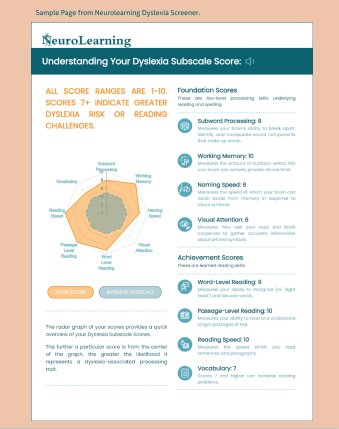 Congratulations to Drs. Mark Moulton and Brock Eide for their publication of a novel multi-dimensional approach to measuring dyslexia risk.
Congratulations to Drs. Mark Moulton and Brock Eide for their publication of a novel multi-dimensional approach to measuring dyslexia risk.
See publication HERE. This is the paper based on the novel Neurolearning dyslexia screening app.
As the paper describes in its introduction, existing approaches to assessment have been hampered by a number of difficulties.
“Multiple independent risk factors have been implicated in the etiology of dyslexic reading and spelling challenges at the cognitive processing level, including phonological processing, visual attention, working memory, naming speed, processing speed, and implicit learning, as have environmental factors. Genetic studies have revealed a similar heterogeneity, with a recent study revealing 42 genetic loci significantly associated with dyslexia. Not surprisingly, great variability in symptoms can be observed at the clinical level, in which individuals with different blends of risk factors may display quite different clinical presentations, responses to interventions, and long-term prognoses.
This inability to identify a single source or precise clinical presentation for dyslexia has led some to propose that the concept of dyslexia itself is both vacuous and unnecessary, or that it simply denotes poor reading achievement by another name. However, these contentions ignore a substantial body of research literature on dyslexia that has repeatedly identified a core group of subjects that, in the words of the World Federation of Neurology, share the common and readily recognizable experience that “despite conventional classroom experience, [they] fail to attain the language skills of reading, writing and spelling commensurate with their intellectual abilities”.
This discrepancy between general and, especially, verbal ability and reading achievement, particularly in the domains of decoding, spelling, and reading fluency, remains a key component of the dyslexia concept [9]. Additional core features of the emerging consensus on the dyslexia diagnosis include the stipulations that the core functional challenges in dyslexia consist of word- and sub-word-level difficulties with decoding, spelling, and reading fluency and that these challenges are produced by the kinds of independent risk factors that produce the lower-level processing challenges cited above.”
RECOGNIZING THE MULTIFACTORIAL NATURE OF DYSLEXIA
An important point that the paper mentions is that the multifactorial and multidimensional characteristics of dyslexia does not mean that the dyslexic condition does not exist; the paper discusses that dyslexia is analogous to many clinical conditions – like acute shock or high blood pressure – these conditions may have various causes, yet they have distinct practical consequences. It’s important to know when auditory processing may contribute to dyslexia; these factors can also contribute significantly to academic challenges such as foreign language learning and test-taking in the presence of auditory distractions.
A tremendous problem with the US public school system’s current approach to dyslexia is that it fails to recognize both contributing factors and impacts on various aspects of school tasks. As important as reading is for dyslexic students, it is also shocking how little some school-based experts in the US know about beyond reading.
Dyslexia also can fall in-between psychology, neurology, and education, so even after saving up to pay thousands of dollars for a comprehensive evaluation, testing may not give you the comprehensive picture and advice that people need.
“Attempts to measure, model, define, and diagnose clinical syndromes will inevitably fail if relevant information is neglected or if the measurement techniques employed fail to adequately sample and represent the data. In the case of dyslexia, the intrinsic complexity and multidimensionality of dyslexia has thus far hindered the identification of a single measure or clinical result that can be used to make a diagnosis [4]. Many attempts to devise simple screening tools have failed to sufficiently represent diagnostic and theoretic core features, such as ability–achievement discrepancy, multifactorial causality…” — (Moulton and Eide, 2023)
There are other potential benefits in Neurolearning Dyslexia Screener – like the fact that this assessment allows people’s profiles to be compared using different instruments and dyslexia scores can help following individuals after intervention and over time.
For those interested in the technical side, the Neurolearning Screener also includes misfit criteria in its algorithm, so an individual’s pattern of correct and incorrect answers can be assessed to see if it fits the pattern of a person with dyslexia or is more likely to result due to mistakes secondary to inattention or even deliberate malingering.
An example of how the dyslexia subscale scores are present can be seen below.
By separating out some of the foundational contributors to difficult reading, test-takers can see which factors underlying reading are contributing to current difficulties, then the generated report suggests resources, tech, and educational work tailored to what the screening found.
In the discussion of this paper, the author discusses the provocative question – are the Dyslexia Risk Scales from the Neurolearning App “more true” than those of existing instruments?:
“This question must fall under the category of ‘future research.’ No comparisons with existing dyslexia instruments, such as dyslexia screeners currently used by school districts to flag students, have yet been attempted. However, there are grounds for suspecting that when such comparisons are performed, the DRS scores will not be found to be highly correlated to existing instruments. Most instruments have less than 50 items, with no timing items, and are analyzed implicitly assuming unidimensionality. The DRS has roughly 443 items per person, includes timings, and locates persons in an empirically determined 6-dimensional space. This is virtually an order of magnitude more data per person…”















